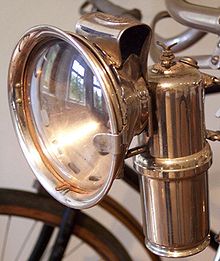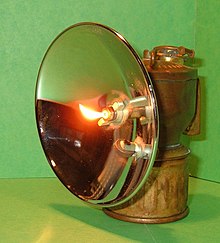Carbide lamp


A carbide lamp is a gas lamp in which the fuel is transported in chemically bound form - usually as calcium carbide - and is only converted into gas shortly before combustion .
history
In 1892 Thomas Willson invented a method for the economical production of calcium carbide, from which acetylene could in turn be obtained. After that, carbide lamp lighting was introduced in buildings from 1894 and on bicycles and other vehicles from 1896.
The patent for the first pit carbide lamp was filed by Frederic E. Baldwin in New York on October 18, 1899 . This was published on August 28, 1900.
functionality
The body of the lamp consists of two containers placed one above the other. The lower container of the lamp contains calcium carbide , onto which water drips from the upper container .
- Calcium carbide reacts with water to form ethine and calcium hydroxide .
The resulting ethine gas (common name: acetylene) leaves the lower container through a short pipe that ends in a burner that is fixed in front of a concave metal mirror . The escaping gas is ignited at the burner. The glaring flame is focused by the mirror and used for lighting. The nozzle used to be made of metal or soapstone , later of ceramic.
Mostly calcium hydroxide (slaked lime) remains as residue in the lower container . If the flame is disturbed by a draft or if it burns too big due to irregularly high pressure or if the nozzle is contaminated, a lot of soot can be produced.
use
Vehicle and signal lamps
Carbide lamps were widely used as vehicle lamps on bicycles and motor vehicles, as well as on the railroad. There, in particular, they were used to illuminate the night signs of the shape signals until the 1950s . After that, they were increasingly replaced by low-maintenance electrical lighting. Up until the end of the 1970s, shunters and wagon masters at the Deutsche Reichsbahn used portable carbide lamps, which are considerably brighter than battery-operated lamps, while the shape signals were illuminated with propane gas from bottles .
Mining
Carbide lamps had a long tradition as pit lamps for every buddy, even in underground mining .
Caving
In the past, only carbide lamps were used in cave exploration . Even when electric lights became available, the carbide lamp remained widespread because of its greater luminous efficacy and lower operating costs, as well as its lower overall weight and robustness. Only in the last few years has it been increasingly replaced by LED lamps .
Modern carbide lamps differ from traditional ones in terms of their design: In the modern version, the lamp is divided into the individual components developer and burner, which are connected to one another by means of a hose. Most of the time, the developer is attached to the harness while the torch is mounted on the helmet, which leaves the cave explorer's hands free to work and move around. Most carbide developers have a vent to equalize the pressure. The horizontal position can lead to water loss when silting . To counteract this, some models can be locked with a screw and operated as an internal pressure system. However, such developers are more difficult to regulate.
Advantages of carbide lamps in caving
- high reliability, as few and hardly error-prone components are used
- Possibility of repair: most errors can be eliminated on site with simple means.
- Gas generator and flame give off heat, heat source in cold, alpine caves (this is particularly advantageous in emergencies with an unplanned long stay in the cavity)
- All-round light
- the warm color tone is perceived by some people as more pleasant
Disadvantages of carbide lamps in caving
- Soot build-up contaminates the cavity
- Calcium carbide Hazardous substance, acetylene explosive, very toxic residues, as the carbide always contains calcium phosphide , derivatives also toxic
- Loss of water from the carbide lamp when slipping is possible
- unpleasant odor development (due to contamination of the carbide) in small and poorly ventilated caves
- In extreme cases, the unburned gas can also develop an anesthetic effect (as happened in Mordloch , Baden-Württemberg)
- the light can be extinguished by drafts, water or incorrect operation of the developer - if this happens at an inconvenient moment, it becomes dangerous without "accompanying" light
- Danger of ropes or other equipment being ignited or melted
- The calcium carbide supply can inadvertently develop flammable gas and heat through the ingress of water
- The gas generator and burner nozzle must be cleaned occasionally
literature
- Karsten Porezag: The miner's glow . tape 2 : Open light: carbide lamps . Glückauf Verlag, Essen 1982, ISBN 3-7739-0382-0 .
- Karl Heupel, Dieter Stoffels: Pit lamps from Sweden. Focus on carbide lamps. With information about handcuffs and special lamps from Scandinavia. Elfriede Verlag, Wilnsdorf 2004, ISBN 3-931667-03-0 .
- Thomas Zollinger: Carbide mine lamps, made in Switzerland. In: Bergknappe. Friends of Mining in Graubünden, No. 1/2006, pp. 8–11.
- Peter W. Card: Early Cycle Lighting. The Crowood Press, Ramsbury 2007, ISBN 978-1-86126-964-5 , section: 1896-1905. The Age of Acetylene Gas. (English)
Web links
- Radio lamp of the Swiss Army, manufactured by Usine Decker SA , (Erik Leger)
- Carbide lamp: experiment instructions and video (Eduard Job Foundation for Thermo- and Material Dynamics)
- Information on the carbide lamp (Karl Heupel)

